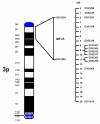A second locus for Marfan syndrome maps to chromosome 3p24.2-p25
- PMID: 7632217
- PMCID: PMC2045693
- DOI: 10.1038/ng1194-264
A second locus for Marfan syndrome maps to chromosome 3p24.2-p25
Abstract
Marfan syndrome (MFS) is an autosomal dominant connective-tissue disorder characterized by skeletal, ocular and cardiovascular defects of highly variable expressivity. The diagnosis relies solely on clinical criteria requiring anomalies in at least two systems. By excluding the chromosome 15 disease locus, fibrillin 1 (FBN1), in a large French family with typical cardiovascular and skeletal anomalies, we raised the issue of genetic heterogeneity in MFS and the implication of a second locus (MFS2). Linkage analyses, performed in this family, have localized MFS2 to a region of 9 centiMorgans between D3S1293 and D3S1283, at 3p24.2-p25. In this region, the highest lod score was found with D3S2336, of 4.89 (theta = 0.05). By LINKMAP analyses, the most probable position for the second locus in MFS was at D3S2335.
Figures



Comment in
-
The question of heterogeneity in Marfan syndrome.Nat Genet. 1995 Mar;9(3):228-31. doi: 10.1038/ng0395-228. Nat Genet. 1995. PMID: 7773282 No abstract available.
References
-
- McKusick VA. The cardiovascular aspects of Marfan’s syndrome: A heritable disorder of connective tissue. Circulation. 1955;11:321–342. - PubMed
-
- Pyeritz RE, McKusick VA. The Marfan syndrome: Diagnosis and management. New Eng J Med. 1979;300:772–777. - PubMed
-
- Beighton P, et al. International nosology of heritable disorders of connective tissue, Berlin, 1986. Am J med Genet. 1988;29:581–594. - PubMed
-
- Kainulainen K, Pulkkinen L, Savolainen A, Kaitila I, Peltonen L. Location on chromosome 15 of the gene defect causing Marfan syndrome. New Eng J Med. 1990;323:935–939. - PubMed
Publication types
MeSH terms
Substances
LinkOut - more resources
Full Text Sources
Other Literature Sources
Medical
Research Materials

